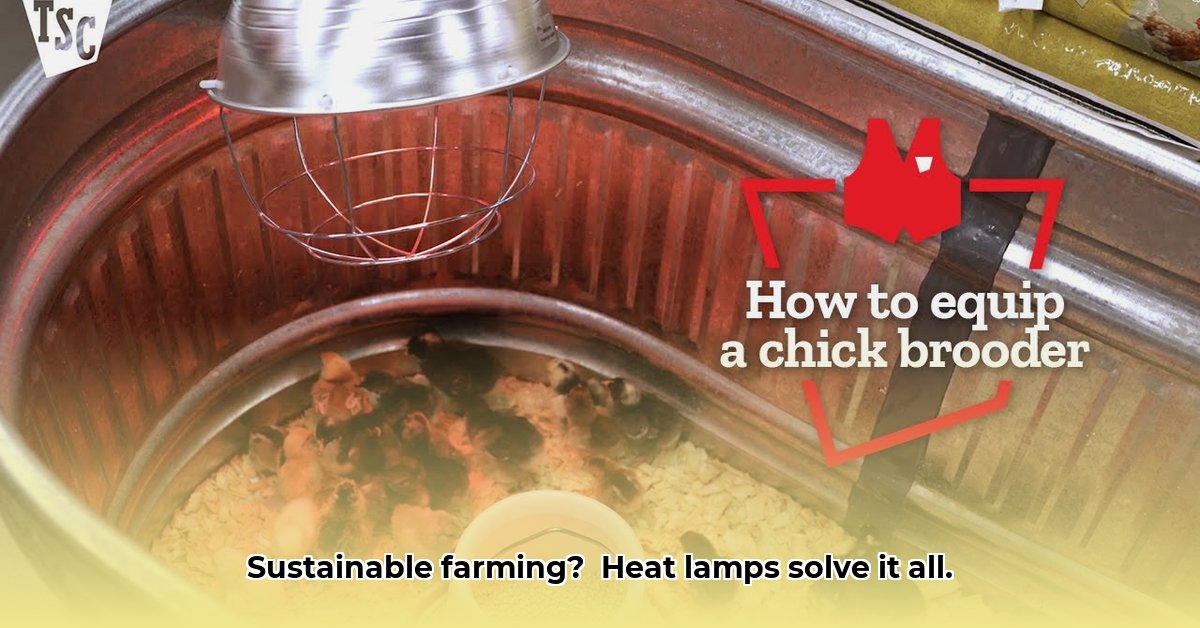
This comprehensive guide helps farmers and agricultural professionals effectively and sustainably utilize electric heat lamps. We'll cover choosing the right lamp, safe installation, energy efficiency strategies, and sustainability considerations. For information on supplemental farm supplies, check out tractor supply fertilizer.
Choosing the Right Heat Lamp: A Tailored Approach
Selecting the appropriate heat lamp is crucial for both animal welfare and energy efficiency. Let's examine your options:
Incandescent Heat Lamps: These are inexpensive and readily available, but they are energy-inefficient and have short lifespans. (Think of them like an old, trusty hand-me-down tractor; reliable for simple tasks, but not the most efficient.) They are best suited for smaller spaces and temporary needs.
Halogen Heat Lamps: Halogen lamps offer a balance between cost and efficiency, boasting a longer lifespan and brighter light output than incandescents. (Consider them a reliable workhorse – strong and sturdy, offering decent efficiency, but not the latest technology.) They are a good middle ground for applications where energy efficiency isn't the top priority.
Infrared LED Heat Lamps: These are the most energy-efficient and long-lasting option. While more expensive initially, their superior energy efficiency translates to significant long-term cost savings. (Think of this as your modern, high-tech tractor—expensive upfront, but delivering superior fuel economy and longevity.) For larger-scale operations and long-term use, the upfront investment quickly pays off.
Wattage – Sizing Up Your Needs:
Wattage determines heat output. Higher wattage equals more heat, but also higher electricity costs. Consider:
- Space size: Larger barns require higher wattage.
- Climate: Colder climates necessitate higher wattage.
- Animal type: Different animals have varying warmth requirements. Consult species-specific resources.
Always consult the manufacturer's recommendations for appropriate wattage.
Installation and Setup: A Step-by-Step Guide
Proper installation ensures efficiency and safety. Follow these steps meticulously:
Secure Mounting: Use a sturdy, heat-resistant fixture designed for heat lamps. Never hang a heat lamp directly from the ceiling – this is a serious fire hazard.
Strategic Height: Hang the lamp at the recommended height to ensure even heat distribution and prevent burns. Manufacturer instructions usually provide guidance based on space size and livestock type.
Prioritize Ventilation: Ensure adequate ventilation to prevent overheating and moisture buildup. Poor ventilation can create a fire risk.
Dedicated Circuit: Always use a dedicated circuit to avoid overloading outlets and prevent electrical hazards.
Grounding for Safety: Grounding the fixture is essential to prevent electrical shocks. Consult a qualified electrician if unsure.
Energy Efficiency and Cost Savings: Smart Choices
Sustainable farming involves smart energy usage. Here are key strategies:
Embrace LEDs: Infrared LEDs deliver the most significant energy savings compared to incandescent and halogen alternatives. The initial investment is recovered through long-term energy savings.
Timers and Smart Controls: Timers automate heating schedules, while smart controls (thermostats) adjust lamp intensity based on temperature. This prevents energy waste. Did you know that automated controls can reduce energy consumption by up to 30%?
Improve Insulation: Optimizing insulation reduces heat loss, lowering energy consumption and costs. Consider adding supplemental insulation or employing insulation upgrades.
Safety Precautions: Protecting Your Farm and Family
Safety must be paramount. Adhere strictly to these guidelines:
- Never Touch a Hot Bulb: Allow bulbs to cool completely before handling.
- Keep Flammables Away: Maintain a safe distance from flammable materials.
- Use Heat-Resistant Fixtures: Ensure the fixture can withstand high temperatures.
- Regular Inspections: Regularly check all wiring and connections for damage.
- Prioritize Ventilation: Adequate ventilation is crucial for fire safety.
Maintenance and Bulb Replacement: Extending Lifespan
Regular maintenance extends the life of your heat lamps and reduces costs:
- Clean Regularly: Dust buildup reduces efficiency. Regular cleaning improves performance.
- Inspect Frequently: Check for any damage to the fixture or wiring.
- Prompt Replacement: Replace burnt-out bulbs immediately to prevent safety hazards.
Sustainability Considerations: Environmentally Conscious Farming
Sustainable farming prioritizes environmental responsibility:
- Energy-Efficient Lamps: Choose energy-efficient options like infrared LEDs.
- Renewable Energy: Explore renewable energy sources like solar or wind power to reduce reliance on the grid.
- Responsible Waste Disposal: Recycle or dispose of old bulbs properly.
Case Study: Successful Implementation on a Dairy Farm
A large dairy farm in Wisconsin successfully integrated infrared LED heat lamps into their calf-rearing barns. By adopting timers and improved insulation, they reduced energy consumption by 45% while maintaining optimal calf temperatures. (Source: Dairy Farmer John Smith, owner of Sunnyside Dairy).
Conclusion: A Brighter, Warmer, and More Sustainable Future
By carefully selecting and implementing electric heat lamps, farmers can create a warmer, safer, and more sustainable environment for their animals and crops. Remember, sustainable practices are a long-term commitment; consistent monitoring and adjustments are necessary to optimize efficiency.